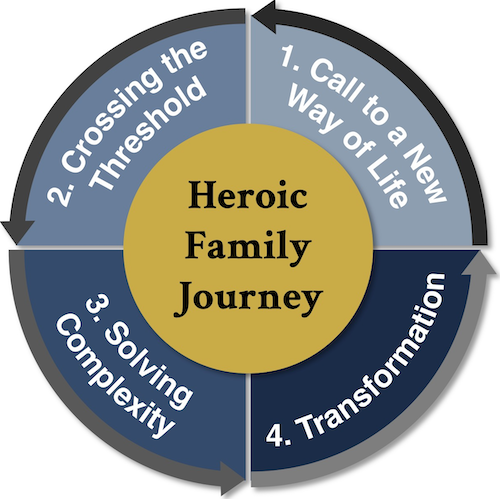
“… discover for yourself what is necessary and what is superfluous.” (Seneca, Ep. 110)
“90 percent of success is not getting distracted.” — Shane Parrish
Superfluous (adjective) su̇-ˈpər-flü-əs
: exceeding what is sufficient or necessary : EXTRA
At a Glance
One of the keys to happiness and productivity is learning how to prioritize. In the internet age this is more difficult than ever as there are quickly increasing demands on our attention. The danger is that we can get sucked into spending precious resources on something that doesn’t really matter, and which may take us further away from goals that we want to achieve. Principles of decision-making for the rising gen (rising generation) should center around teaching the rising gen to ask, “what is necessary for and what is superfluous?”
- Voluntarily limit choices to reduce decision fatigue.
- Discover your personal hero’s journey story.
- Use your story to figure out priorities and goals.
- Clear the clutter that is weighing you down on your journey.
The Tyranny of Choice
Wealth can introduce excessive demands and pressures on time by giving virtually unlimited choices. It removes the constraints on what is possible, even though one’s time and energy is still finite. In an ultra-high-net-worth family, first-generation wealth owners have probably become successful because they were able to prioritize business goals. However, their children or grandchildren, the rising gen, are natives of the “land of wealth.” Therefore, they have to discover for themselves how to avoid the distractions that wealth poses and to find their own voice within it. Decision-making for the rising gen can easily become clogged with an abundance of choices.
The additional choices caused by wealth, even if the choices are good ones, can cause stress. Take, for example, a teenager who is presented with the possibility of a family vacation, travel with friends, a job, an internship, or additional school in their junior year summer vacation. We have observed some young people in this situation become decision-averse and avoid picking one wholeheartedly, making them less happy than if they had only one or two options.
Some of the most successful people purposely limit their options. Famously, Mark Zuckerberg wears the same thing every day (as did Barack Obama when he was in the White House). Warren Buffet has lived in the same house for decades. These people realize that success lies in not letting the superfluous distract from the necessary. Though these examples are quite extreme (one doesn’t need a monastic existence to be happy) it is important to have a way to automatically limit decisions.
The Rise of Hyperchoice
There is interesting psychological research on what happens when there is an excess of choices. It reveals that the “hyperchoice” of modern society, exacerbated by affluence, may result in choice fatigue, lower life-satisfaction, irrational decision-making, decreased willpower, and lower self-esteem.[1] Professor Barry Schwartz terms this the “Tyranny of Choice” and writes, “Americans are awash in choice… Further, freedom of choice is greatly enhanced by increased affluence. In the last 40 years, the inflation-adjusted, per capita income of Americans has more than doubled. This increased affluence contributes to freedom of choice by giving people the means to act on their various goals and desires, whatever they may be. Does increased affluence and increased choice mean we have more happy people? Not at all… Indeed, …we are actually experiencing a decrease in well-being.”
Paradoxically, freedom can result when choices are limited, allowing us to use our finite mental resources on other things. Naturally enough, this limitation must come from oneself, as there are no morally or societally acceptable ways to take choices away from people.
This forms a strong reason for making prioritization and decision-making a significant part of an independent or family education program. There are many good resources that assist young people in learning goal setting and decision making. For example, Act for Youth based at Cornell University, provides free resources and games oriented towards teaching these skills. Rather than reinvent what has been done well, this article presents a different and complementary approach to decision-making.
Stories Help Decision
In most good stories, the reader is eager to find out what the protagonist decides to do next, and what the impact of that decision is. In some ways we can simulate our own experiences by identifying with this character and the way he or she orients physical, social, or emotional circumstances. Furthermore, a good story always prioritizes what is important. For example, authors generally do not spend chapter after chapter describing something irrelevant to the plot—they would lose their readers quickly.
We can take these principles of storytelling and apply them to life. Imagine your life as a story—what characters, actions, and decisions are essential to driving the plot forward? What is your (the protagonist’s) decision-making process? What are pleasant diversions to the plot? What are dangerous distractions?
What Makes a Story
At our firm we use the Heroic Family Journey to describe our client process. One of the great things about this format is that it can explain the activities of the whole family https://grupplaw.com/insights/family-story/ or the individual family members.

The Call to a New Way of Life
First there is a call to adventure. The hero receives a message (perhaps through a dream or seeming coincidence) that opens their field of view. The hero cannot get this new idea out of their head. Next, the hero has to make a yes or no decision whether to pursue this call. The hero usually refuses the call at first, due to fear, doubt, or a sense of inadequacy. At this point a mentor may come along to help the hero change his mind and offer the first clue as to what to do next.
Crossing the Threshold
The hero takes the first step into the unknown and crosses the threshold into a world of tests, trials, and challenges. Along the way, the hero gains abilities and confidence. At this point, the hero approaches the innermost cave or the heart of darkness to face the ultimate challenge.
Solving the Challenge
This is the moment of the hero’s greatest challenge, where they face a major obstacle or enemy and must overcome it to continue their journey. To overcome this, the hero must make a sacrifice that fundamentally changes who they are and how they see the world. In return, the hero achieves a reward—often in the form of knowledge or insight.
Transformation
The hero has experienced a rebirth and returns home, transformed, and changed by their experiences, armed with new knowledge and insights that they can use to benefit their community.
Brainstorm
To learn to prioritize what is necessary, rising gen members can discover and tell their own story. They may need some encouragement and prompts. Usually the response initially is, “Nothing has happened to me.” However, once the ideas begin to flow, teens and young adults often have no difficulty in writing what they enjoy, what they fear, what they aspire to do, and what they dislike doing. Here is a list of questions to consider:
- What is my Call?
- When does my current story start?
- Who is my Mentor?
- What do I fear?
- What is my greatest challenge?
- What would I change about my life if I could?
- What would I change in my community/the world if I could?
Tell the Story
Using this brainstorm and the hero’s journey format, the next step is to construct a story that provides a clearer idea of what the ultimate goals and challenges are. This in turn provides a way to discuss priorities and decision-making.
A further exercise to add to this activity is to imagine you are packing for a three-week trip in a small backpack. Where are you going and what do you need take? It’s difficult but possible. There cannot be any extra items, just the necessary things. Then translate this idea back to the hero’s journey story. What’s in your backpack? What items do you need to reach your destination? The goal is not to bring clutter with you on your journey, in the same way you wouldn’t pack your childhood toy collection on a backpacking trip.
Clearing Clutter
In The Myth of the Silver Spoon, Kristin Keffeler explains the three kinds of clutter that many rising gens have and how to clear it.[2]
Money Clutter: you may not know about how money works and are afraid to find out. Instead build financial skills. Learn how to budget, invest, give, and earn money.
Identity Clutter: you may under-identify with the family’s wealth and try to ignore or avoid it—even acting out to try to get away from “the family name”. Or you may over-identify with family wealth by seeing it as a fundamental part of who you are. Both of these are unhelpful in the long run.
Relationship Clutter: sometimes wealth can create complexity in relationships and unspoken power dynamics. To clear this clutter, you need to be open about who you know that supports you fully as who you are. Strive to bring positivity and good qualities other than wealth to your relationships. And lastly, imagine what a good relationship or friendship would look like, and then make active steps towards it.
Summary
In conclusion, young people, especially those from affluent families, must master prioritization and decision-making in an environment rich with choices. The rising gen can harness storytelling and the hero’s journey framework as tools to distinguish necessary actions from mere distractions. Actively decluttering life aspects such as financial knowledge, personal identity, and relationships is crucial, providing clarity and purpose. This approach equips the younger generation with their own decision-making process so that they can forge their own paths within the family legacy.
[1]David Glen Mick, Susan M. Broniarczyk, and Jonathan Haidt. “Choose, Choose, Choose, Choose, Choose, Choose, Choose: Emerging and Prospective Research on the Deleterious Effects of Living in Consumer Hyperchoice,” Journal of Business Ethics 52, no. 2 (2004); 207–11, http://www.jstor.org/stable/25123247.
[2] Kristin Keffeler. The Myth of the Silver Spoon (Hoboken, New Jersey: John Wiley and Sons, 2023).
